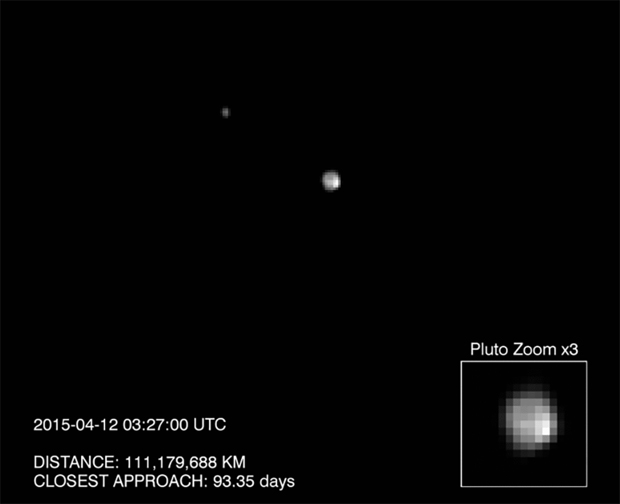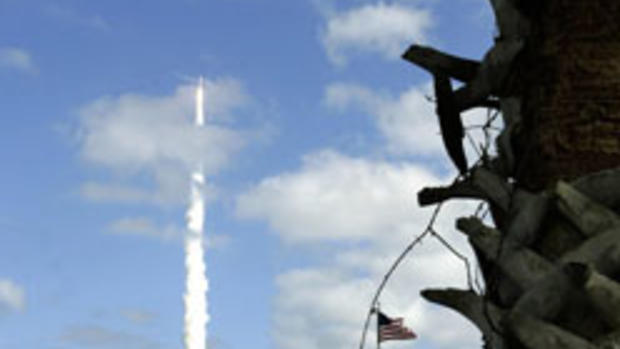NASA probe detects possible polar cap on Pluto
New photos and animations of Pluto and its large moon Charon taken by the fast-approaching New Horizons probe are revealing distinct surface features for the first time, including a bright area that could be a snowy polar cap, mission managers said Wednesday.
Launched in 2006, the New Horizons spacecraft, built by the Applied Physics Laboratory at Johns Hopkins University, is now just two months away from a historic flyby of the dwarf planet on July 14.
Still some 70 million miles from its target, dramatic animation assembled from photographs taken with an 8-inch telescope aboard the spacecraft show Charon orbiting Pluto in a circle as if viewed from directly above with the planet wobbling back and forth around their common center of gravity. Four other moons discovered by the Hubble Space Telescope are not yet visible to New Horizons.
Pluto rotates on its side much like the planet Neptune with Charon completing one trip around the world every 6.4 days. Charon does not yet show any major brightness variations, but Pluto is a different story.
"Imagine Pluto on its side, you're looking down essentially on the poles and it's rotating before us like a chicken on a barbecue spit, an almost perpendicular rotation axis to our line of sight," said Alan Stern, the New Horizons principal investigator at the Southwest Research Institute in Boulder, Colo. "Those features are real features on the surface of Pluto, seen for the first time by the New Horizons spacecraft.
"In fact, these images are jut a little bit better than anything that's ever been obtained in history," he said. "They allow us to see that Pluto has very broad surface markings, a wide range of reflectivities on its surface, that there are structures hundreds of miles across that are coherently rotating around the equatorial zone."
At the 3 o'clock position on the planet, "you'll see the image always remains bright," Stern said. "That's a pole, and that may be evidence for a polar cap, which would be very, very exciting. Whether it's actually a polar cap or not depends upon data we'll be collecting in the future, compositional data from our spectrometers, which will begin to come in when we're closer in June."
Hal Weaver, the mission project scientist, said even at Pluto's vast distance from the sun, very slight temperature variations can produce polar caps.
"The polar cap is a region that's normally a little bit colder than the rest of the surface, and that's where these volatile ices can condense on the surface," he said. "And that's what we think we're seeing. In another month and a half, we're going to actually map the composition, so we'll be able to tell whether or not there's really ice, whether those brightest regions are really ice, snowy patches."
Darker regions presumably include organic compounds, he added, which likely give Pluto a dull reddish color overall.
"These are guesses at this point," Weaver said. "And that's the reason we're doing this mission."
If all goes well, New Horizons will make its closest approach to Pluto at 7:49:59 a.m. EDT (GMT-4) on July 14, passing within 7,770 miles of the planet's surface at a relative velocity of some 31,000 mph. At that distance, its cameras will be able to detect features just 200 feet or so across.
The probe's instruments will photograph Pluto and Charon at visible and near-infrared wavelengths, study their surface composition and search for additional moons.
After passing through the Pluto system, New Horizons will continue on into the Kuiper Belt, a vast region of icy debris left over from the birth of the solar system 4.6 billion years ago. NASA is evaluating Kuiper Belt bodies discovered by the Hubble Space Telescope that New Horizons may be able to study during one or more flybys in the years ahead.
Scientists can hardly wait.
"After making this crossing of 114 months and having only a little over two months to go, we on the New Horizons team feel a little bit like ocean mariners, explorers, crossing between continents, weeks and weeks on the ocean in their case, nine and a half years in our case," Stern said. "And we can finally see the shore. That's land ho. And I have to tell you, the images are going to get better and better from here on out."


